2016年备课仁爱版八年级英语下册课件 3AUnit 7 Topic 2 I’m not sure whether I can cook it well Section D
文档属性
| 名称 | 2016年备课仁爱版八年级英语下册课件 3AUnit 7 Topic 2 I’m not sure whether I can cook it well Section D |  | |
| 格式 | zip | ||
| 文件大小 | 1.3MB | ||
| 资源类型 | 教案 | ||
| 版本资源 | 科普版 | ||
| 科目 | 英语 | ||
| 更新时间 | 2017-04-01 17:00:21 | ||
图片预览

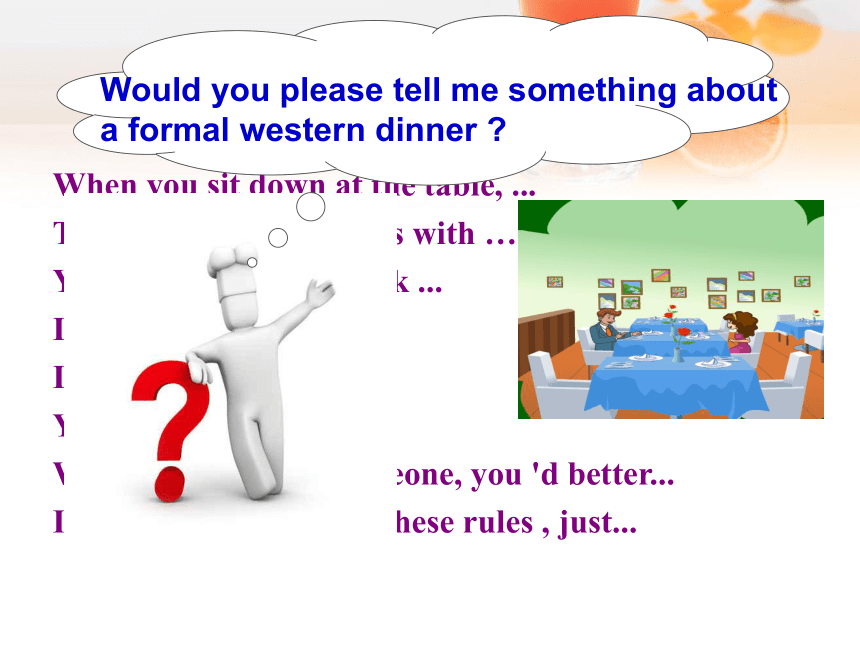
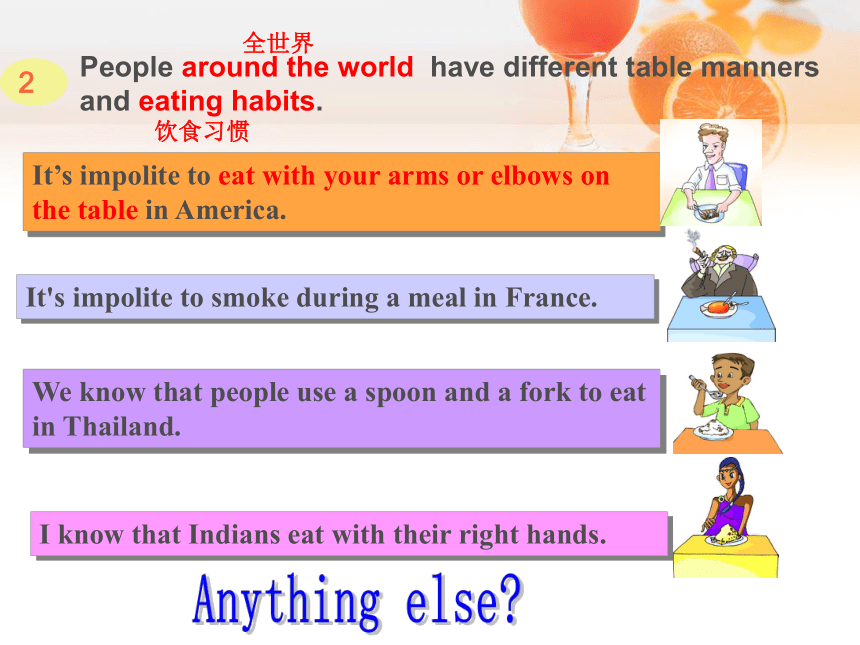
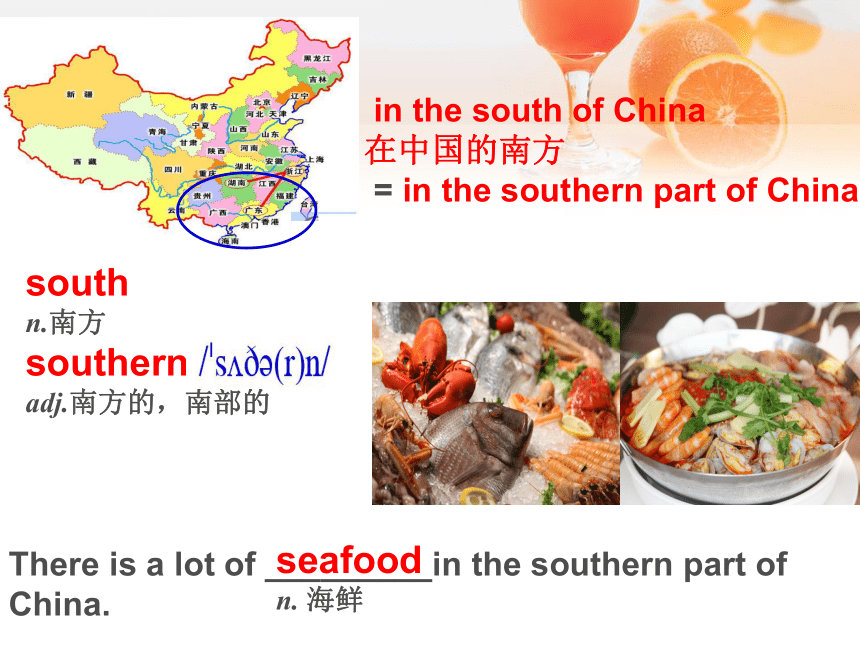
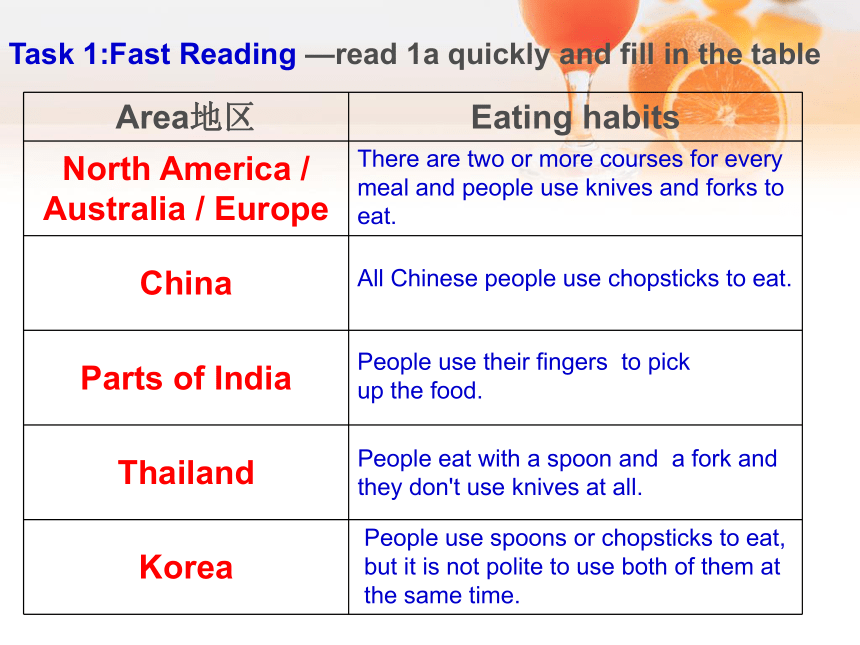
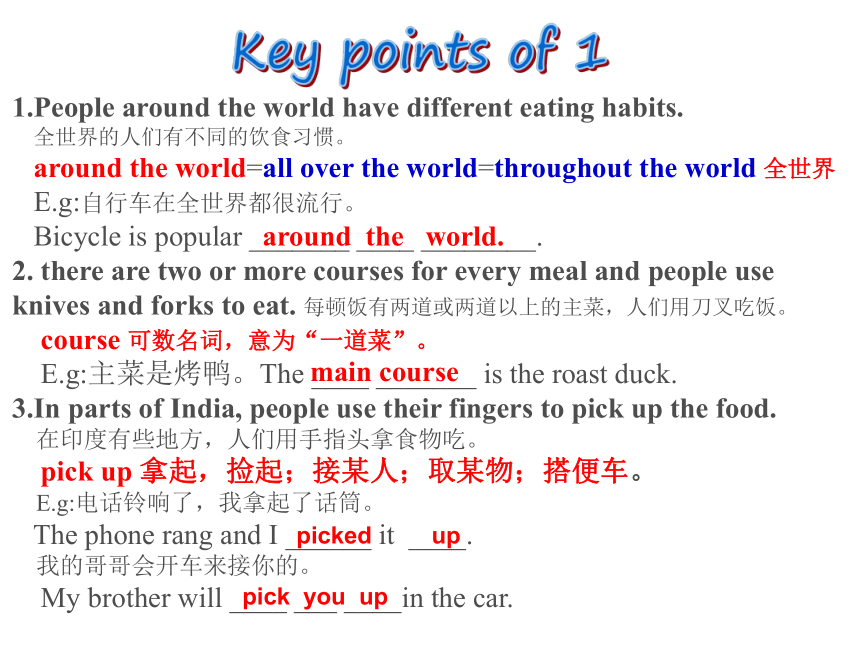
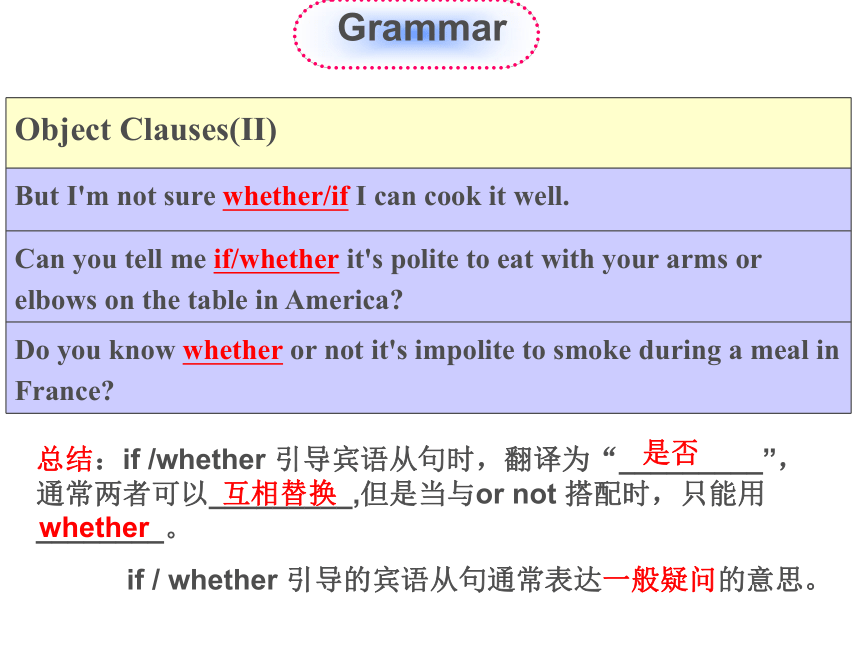

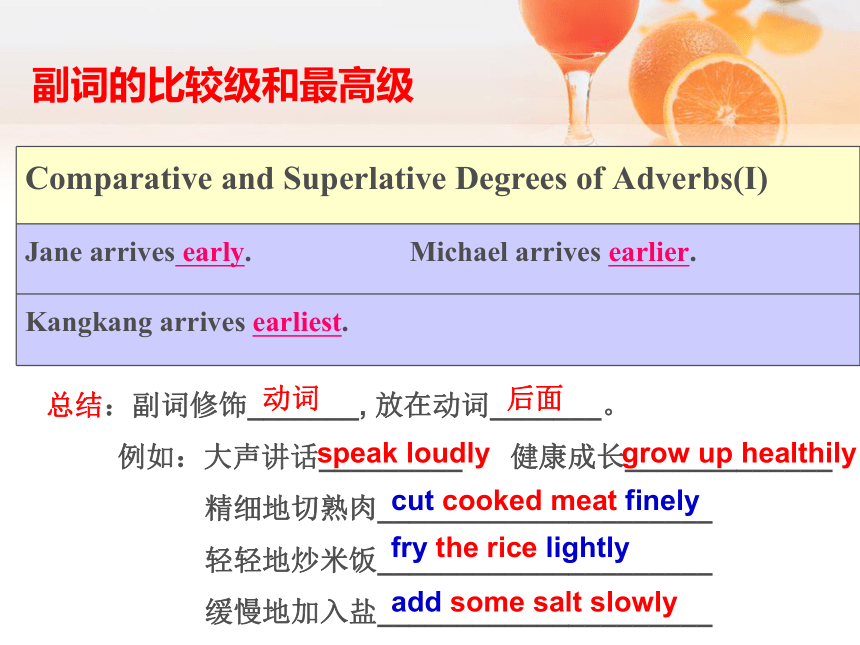
文档简介
课件20张PPT。Unit 7 Food Festival Topic 2 I’m not sure whether I can cook it well.Section DWhen you sit down at the table, ...
The dinner always starts with …
You should keep the fork ...
If you use your knife, ...
It’s polite to eat up…
You should speak …
When you drink to someone, you 'd better...
If you can’t remember these rules , just...Would you please tell me something about
a formal western dinner ?It’s impolite to eat with your arms or elbows on the table in America. It's impolite to smoke during a meal in France.We know that people use a spoon and a fork to eat in Thailand. I know that Indians eat with their right hands.People around the world have different table manners and eating habits. 2全世界饮食习惯Anything else?south
n.南方
southern
adj.南方的,南部的There is a lot of _________in the southern part of China.seafood n. 海鲜 in the south of China
在中国的南方
= in the southern part of ChinaThere are two or more courses for every
meal and people use knives and forks to
eat.All Chinese people use chopsticks to eat.People use their fingers to pick
up the food.People use spoons or chopsticks to eat,
but it is not polite to use both of them at
the same time.People eat with a spoon and a fork and
they don't use knives at all.Task 1:Fast Reading —read 1a quickly and fill in the table 1.People around the world have different eating habits.
全世界的人们有不同的饮食习惯。
around the world=all over the world=throughout the world 全世界
E.g:自行车在全世界都很流行。
Bicycle is popular _______ ____ ________.
2. there are two or more courses for every meal and people use knives and forks to eat. 每顿饭有两道或两道以上的主菜,人们用刀叉吃饭。
course 可数名词,意为“一道菜”。
E.g:主菜是烤鸭。The ____ _______ is the roast duck.
3.In parts of India, people use their fingers to pick up the food.
在印度有些地方,人们用手指头拿食物吃。
pick up 拿起,捡起;接某人;取某物;搭便车。
E.g:电话铃响了,我拿起了话筒。
The phone rang and I ______ it ____.
我的哥哥会开车来接你的。
My brother will ____ ___ ____in the car. Key points of 1around the world.pick you up picked upmain courseGrammar总结:if /whether 引导宾语从句时,翻译为“_________”,通常两者可以_________,但是当与or not 搭配时,只能用________。
if / whether 引导的宾语从句通常表达一般疑问的意思。是否互相替换whether Suppose you are Beth.Report the following interview notes to your partner.2Example:
I ask Tom if/whether the most popular food in his restaurant is hot dogs.And he says it is.副词的比较级和最高级总结:副词修饰_______, 放在动词_______。
例如:大声讲话_________ 健康成长_____________
精细地切熟肉_____________________
轻轻地炒米饭_____________________
缓慢地加入盐_____________________动词cut cooked meat finelyfry the rice lightlyadd some salt slowlyspeak loudlygrow up healthily后面Functions3Look at the pictures and write a passage about how to cook chicken soup.cut upwashput...intoboiladd salt,
green onionsready,
enjoy Chicken soup is very delicious, and it’s good for our health. Now let’s cook it together.
First, cut up chicken. Next, wash the chicken . Then,put it into a deep pot 70% -80% full of water. After that, boil the chicken for about 2 hours. Finally, add some salt, green onions and so on. Now the chicken soup is ready and you can enjoy it. ProjectTable Manners in Different CountriesPrepare some hats with country names, such as Japan and
Cuba on them.
The students wearing the hats will do some eating actions.The other students guess and discuss.
What’s he / she doing?
Is it polite to do this during dinner in Japan / Cuba ...?
Is it polite to put arms or elbows on the table in Japan / Cuba ...?
3. Write a passage about table manners in different countries.
( ) 1. Don’t worry. My father will ____ us up in the car if it rains tomorrow.
A. bring B. take C. pick
( ) 2. I don’t know ____ it’s polite or not to eat with our arms or elbows
on the table in America.
A. if B. whether C. that
( ) 3. ---Would you mind if I learn English from you?
---__________. I am very glad to teach you.
A. Of course not. B. You’d better not. C. Sounds great.
( ) 4. All Chinese use chopsticks________.
A. eat B. to eat C. eating
( ) 5.In the _______ part of China,people eat rice and fish a lot.
A. south B. southes C. southern单项选择。CBABCExercises in classdifferent eating habits
North America, Australia, Europe, courses , knives, forks.
southern part of China, rice, north, noodles, central, western, don’t, seafood, chopsticks.
parts of India, fingers, pick up.
Thailand, spoon,fork, don't use knives.
Korea, spoons, chopsticks, not polite, both.Retell the passage with the help of key words.Exercises in class综合短文填空。
When you go to a dinner party in the U.S.A, you’d better bring a small present. It’s nice to bring some d______, such as juice, beer or something like that. You should a_____ on time or no more than five minutes late. Don’t get there e_____. If you are going to be more than fifteen m______ late, you should call them or let them know. Try to be relaxed and p_____. If you don’t know h____ to use the knife and fork, don’t be nervous. You can watch other people and f_____them. If you still have no idea, ask the person n____to you. If you like the food, you should say what you t____ of it. Of course, you should thank the host a_____the meal. Usually a thank-you card is sent after the party.rinksrrivearlyinutesoliteowollowexthinkfterRaed . Eating Habits
People around the world have different eating habits.
In North America, Australia and Europe, there are two or more courses for every meal and people use knives and forks to eat.
In the southern part of China, people eat rice a lot, while in the north people often eat noodles. In the central and western parts, people are far away from the sea, so they don’t eat much seafood. But all Chinese people use chopsticks to eat.
In parts of India, people use their fingers to pick up the food.
In Thailand,people eat with a spoon and a fork and they don't use knives at all.
In Korea, people use spoons or chopsticks to eat, but it is not polite to use both of them at the same time.Talk about eating habits in different parts of the world according to 1.Example:
A: Can you tell me if there are two or more courses for every meal in North America, Australia and Europe?
B: Yes, I think so.
A: Do you know if people in the south of China often eat noodles?
B: No, I don’t think so. But sometimes they do.We learn:We can:1. Some new words:
southern,seafood,pick
2.Some phrases:
eating habits, in the southern part of, pick up, at the same time
3.To review object clauses:
But I'm not sure whether/if I can cook it well.
I ask Tom if/whether the most popular food in his restaurant is hot dogs.
Do you know whether or not it's impolite to smoke during a meal in France? 1.Talk about different eating habits around the world:
In North America, Australia and Europe, there are two or more courses for every meal and people use knives and forks to eat.
In Korea, people use spoons or chopsticks to eat, but it is not polite to use both of them at the same time.
2.Talk about how to cook chicken soup.SummaryHomework1. Read and retell the passage of 1.
2. Write a passage about table manners in
different countries.
3.Finish Section D in your workbook.
4.Review Topic 2 and preview Section A
of Topic 3.
Thank you !
The dinner always starts with …
You should keep the fork ...
If you use your knife, ...
It’s polite to eat up…
You should speak …
When you drink to someone, you 'd better...
If you can’t remember these rules , just...Would you please tell me something about
a formal western dinner ?It’s impolite to eat with your arms or elbows on the table in America. It's impolite to smoke during a meal in France.We know that people use a spoon and a fork to eat in Thailand. I know that Indians eat with their right hands.People around the world have different table manners and eating habits. 2全世界饮食习惯Anything else?south
n.南方
southern
adj.南方的,南部的There is a lot of _________in the southern part of China.seafood n. 海鲜 in the south of China
在中国的南方
= in the southern part of ChinaThere are two or more courses for every
meal and people use knives and forks to
eat.All Chinese people use chopsticks to eat.People use their fingers to pick
up the food.People use spoons or chopsticks to eat,
but it is not polite to use both of them at
the same time.People eat with a spoon and a fork and
they don't use knives at all.Task 1:Fast Reading —read 1a quickly and fill in the table 1.People around the world have different eating habits.
全世界的人们有不同的饮食习惯。
around the world=all over the world=throughout the world 全世界
E.g:自行车在全世界都很流行。
Bicycle is popular _______ ____ ________.
2. there are two or more courses for every meal and people use knives and forks to eat. 每顿饭有两道或两道以上的主菜,人们用刀叉吃饭。
course 可数名词,意为“一道菜”。
E.g:主菜是烤鸭。The ____ _______ is the roast duck.
3.In parts of India, people use their fingers to pick up the food.
在印度有些地方,人们用手指头拿食物吃。
pick up 拿起,捡起;接某人;取某物;搭便车。
E.g:电话铃响了,我拿起了话筒。
The phone rang and I ______ it ____.
我的哥哥会开车来接你的。
My brother will ____ ___ ____in the car. Key points of 1around the world.pick you up picked upmain courseGrammar总结:if /whether 引导宾语从句时,翻译为“_________”,通常两者可以_________,但是当与or not 搭配时,只能用________。
if / whether 引导的宾语从句通常表达一般疑问的意思。是否互相替换whether Suppose you are Beth.Report the following interview notes to your partner.2Example:
I ask Tom if/whether the most popular food in his restaurant is hot dogs.And he says it is.副词的比较级和最高级总结:副词修饰_______, 放在动词_______。
例如:大声讲话_________ 健康成长_____________
精细地切熟肉_____________________
轻轻地炒米饭_____________________
缓慢地加入盐_____________________动词cut cooked meat finelyfry the rice lightlyadd some salt slowlyspeak loudlygrow up healthily后面Functions3Look at the pictures and write a passage about how to cook chicken soup.cut upwashput...intoboiladd salt,
green onionsready,
enjoy Chicken soup is very delicious, and it’s good for our health. Now let’s cook it together.
First, cut up chicken. Next, wash the chicken . Then,put it into a deep pot 70% -80% full of water. After that, boil the chicken for about 2 hours. Finally, add some salt, green onions and so on. Now the chicken soup is ready and you can enjoy it. ProjectTable Manners in Different CountriesPrepare some hats with country names, such as Japan and
Cuba on them.
The students wearing the hats will do some eating actions.The other students guess and discuss.
What’s he / she doing?
Is it polite to do this during dinner in Japan / Cuba ...?
Is it polite to put arms or elbows on the table in Japan / Cuba ...?
3. Write a passage about table manners in different countries.
( ) 1. Don’t worry. My father will ____ us up in the car if it rains tomorrow.
A. bring B. take C. pick
( ) 2. I don’t know ____ it’s polite or not to eat with our arms or elbows
on the table in America.
A. if B. whether C. that
( ) 3. ---Would you mind if I learn English from you?
---__________. I am very glad to teach you.
A. Of course not. B. You’d better not. C. Sounds great.
( ) 4. All Chinese use chopsticks________.
A. eat B. to eat C. eating
( ) 5.In the _______ part of China,people eat rice and fish a lot.
A. south B. southes C. southern单项选择。CBABCExercises in classdifferent eating habits
North America, Australia, Europe, courses , knives, forks.
southern part of China, rice, north, noodles, central, western, don’t, seafood, chopsticks.
parts of India, fingers, pick up.
Thailand, spoon,fork, don't use knives.
Korea, spoons, chopsticks, not polite, both.Retell the passage with the help of key words.Exercises in class综合短文填空。
When you go to a dinner party in the U.S.A, you’d better bring a small present. It’s nice to bring some d______, such as juice, beer or something like that. You should a_____ on time or no more than five minutes late. Don’t get there e_____. If you are going to be more than fifteen m______ late, you should call them or let them know. Try to be relaxed and p_____. If you don’t know h____ to use the knife and fork, don’t be nervous. You can watch other people and f_____them. If you still have no idea, ask the person n____to you. If you like the food, you should say what you t____ of it. Of course, you should thank the host a_____the meal. Usually a thank-you card is sent after the party.rinksrrivearlyinutesoliteowollowexthinkfterRaed . Eating Habits
People around the world have different eating habits.
In North America, Australia and Europe, there are two or more courses for every meal and people use knives and forks to eat.
In the southern part of China, people eat rice a lot, while in the north people often eat noodles. In the central and western parts, people are far away from the sea, so they don’t eat much seafood. But all Chinese people use chopsticks to eat.
In parts of India, people use their fingers to pick up the food.
In Thailand,people eat with a spoon and a fork and they don't use knives at all.
In Korea, people use spoons or chopsticks to eat, but it is not polite to use both of them at the same time.Talk about eating habits in different parts of the world according to 1.Example:
A: Can you tell me if there are two or more courses for every meal in North America, Australia and Europe?
B: Yes, I think so.
A: Do you know if people in the south of China often eat noodles?
B: No, I don’t think so. But sometimes they do.We learn:We can:1. Some new words:
southern,seafood,pick
2.Some phrases:
eating habits, in the southern part of, pick up, at the same time
3.To review object clauses:
But I'm not sure whether/if I can cook it well.
I ask Tom if/whether the most popular food in his restaurant is hot dogs.
Do you know whether or not it's impolite to smoke during a meal in France? 1.Talk about different eating habits around the world:
In North America, Australia and Europe, there are two or more courses for every meal and people use knives and forks to eat.
In Korea, people use spoons or chopsticks to eat, but it is not polite to use both of them at the same time.
2.Talk about how to cook chicken soup.SummaryHomework1. Read and retell the passage of 1.
2. Write a passage about table manners in
different countries.
3.Finish Section D in your workbook.
4.Review Topic 2 and preview Section A
of Topic 3.
Thank you !
同课章节目录
- Unit 5 Feeling excited
- Topic 1 You look excited
- Topic 2 I’m feeling better now.
- Topic 3 Many things can affect our feelings.
- Unit 6 Enjoying Cycling
- Topic 1 We're going on a three-day visit to Mount
- Topic 2 How about exploring Tian’anmen Square?
- Topic 3 Bicycle riding is good exercise.
- Unit 7 Food festival
- Topic 1 We’re preparing for a food festival.
- Topic 2 I’m not sure whether I can cook it well.
- Topic 3 I Cooked the Most Successfully
- Unit 8 Our Clothes
- Topic 1 We will have a class fashion show.
- Topic 2 We can design our own uniforms.
- Topic 3 He said the fashion show was wonderful.
